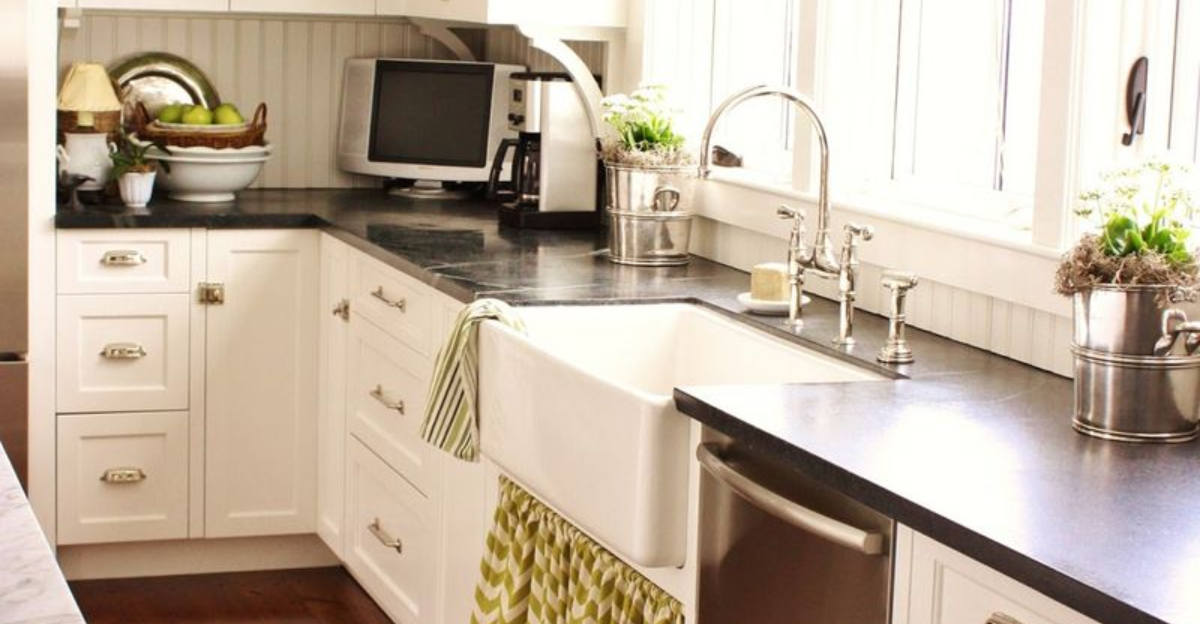Stepping into a cottage kitchen feels like wrapping yourself in a warm quilt of nostalgia and comfort. There’s something magical about spaces that tell stories through chipped paint, well-loved wooden spoons, and the lingering scent of bread rising on the counter.
The good news? You don’t need a thatched roof or countryside views to create this timeless charm. Whether you’re renovating completely or just refreshing your space, cottage kitchens celebrate imperfection and lived-in beauty that welcomes rather than intimidates.
Let’s unlock the secrets to creating a kitchen that feels like it’s been giving hugs for generations.
1. Embrace Open Shelving With Character

Forget precious displays of matching dishes. Real cottage kitchens showcase everyday crockery, mismatched teacups, and hand-me-down serving bowls right where you can reach them. Mount reclaimed wood planks or vintage brackets for shelves that look like they’ve always been there.
Stack white ironstone beside blue willow patterns. Let copper measuring cups nest between cookbooks with dog-eared pages. Your kitchen should work hard and look beautiful in its utility.
2. Hunt Down Vintage Hardware That Tells Stories
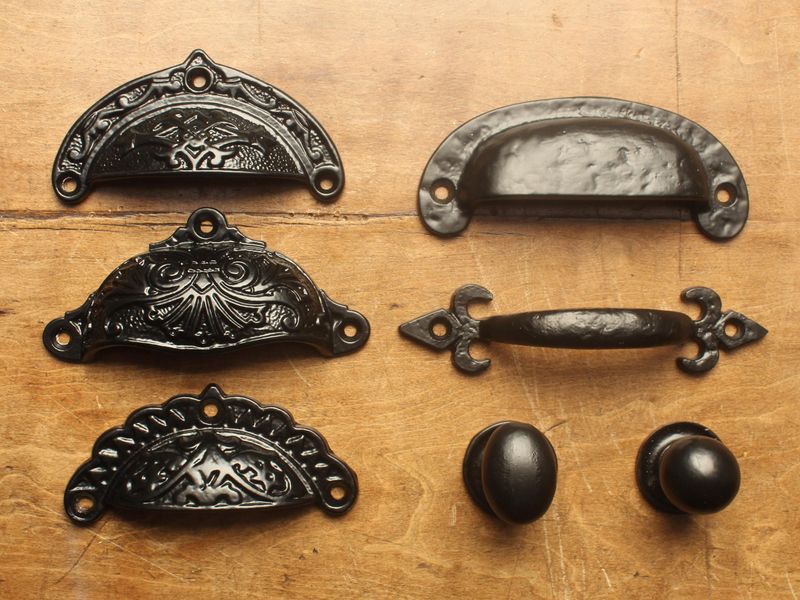
Nothing screams “builder-grade boring” like standard cabinet pulls. Swap them for tarnished brass bin pulls, glass knobs with tiny bubbles trapped inside, or hand-forged iron latches that click satisfyingly when closed.
Scour flea markets for these small treasures – they’re often sold in mismatched lots for pennies. The slight variations in patina and wear mark each drawer and cupboard as uniquely yours, creating instant character without major renovation.
3. Bring In The Butcher Block
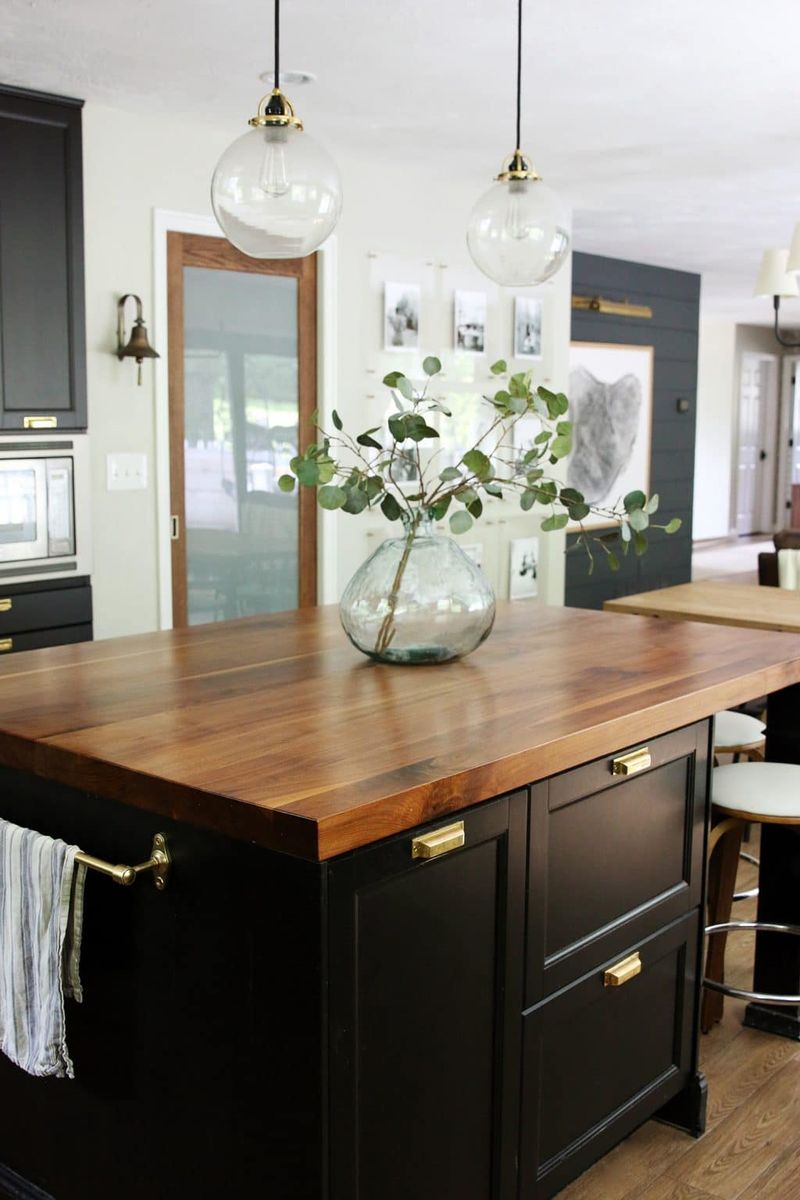
Sleek stone countertops have their place, but nothing ages as gracefully as wood. Butcher block counters develop a soul over time – knife marks, wine stains, and slight warping tell the story of meals shared and memories made.
Choose maple for durability or oak for distinctive grain. Leave sections untreated where you’ll actually chop, and oil the rest with food-safe finishes. Unlike precious surfaces that demand coasters, these counters become more beautiful with use.
4. Install A Farmhouse Sink With Skirts

The humble farmhouse sink offers deep basins perfect for washing garden vegetables or soaking stock pots. Look for fireclay, porcelain, or even concrete versions with apron fronts that extend past cabinetry.
For extra cottage charm, add a gathered fabric skirt underneath open sink areas. Select small floral prints, ticking stripes, or checkered patterns that can be easily changed with seasons. This soft touch balances all the hard surfaces in your kitchen.
5. Mix Patterns With Abandon

Cottage kitchens reject the minimalist mantra of “less is more.” Layer gingham tea towels over striped dish cloths. Hang floral curtains beside botanical-print cushions. Place a braided rag rug atop painted wood floors.
The secret lies in sticking to a limited color palette while varying pattern scale. Perhaps buttery yellows, faded blues, and cream form your foundation. When patterns share these colors, they’ll harmonize beautifully despite their differences – creating depth without chaos.
6. Paint Cabinets In Buttermilk Or Sage
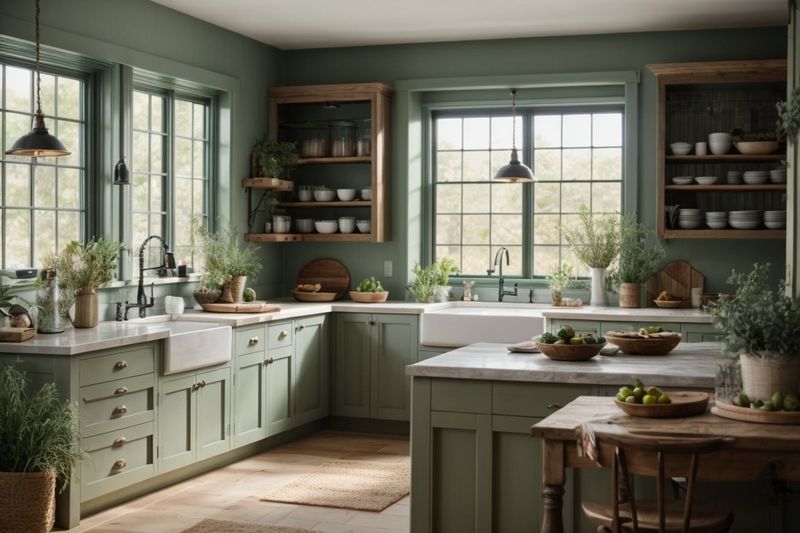
White kitchens feel clinical. True cottage kitchens wear colors pulled from herb gardens and country mornings – muted sage greens, buttery creams, or faded robin’s egg blues. These hues feel timeless rather than trendy.
Choose milk paint or chalk paint for cabinets, allowing subtle brush strokes to show. Sand edges lightly after drying to reveal hints of wood or previous colors underneath. This intentional imperfection mimics decades of gentle wear, creating instant history.
7. Hang Copper Pots Where You’ll Actually Use Them
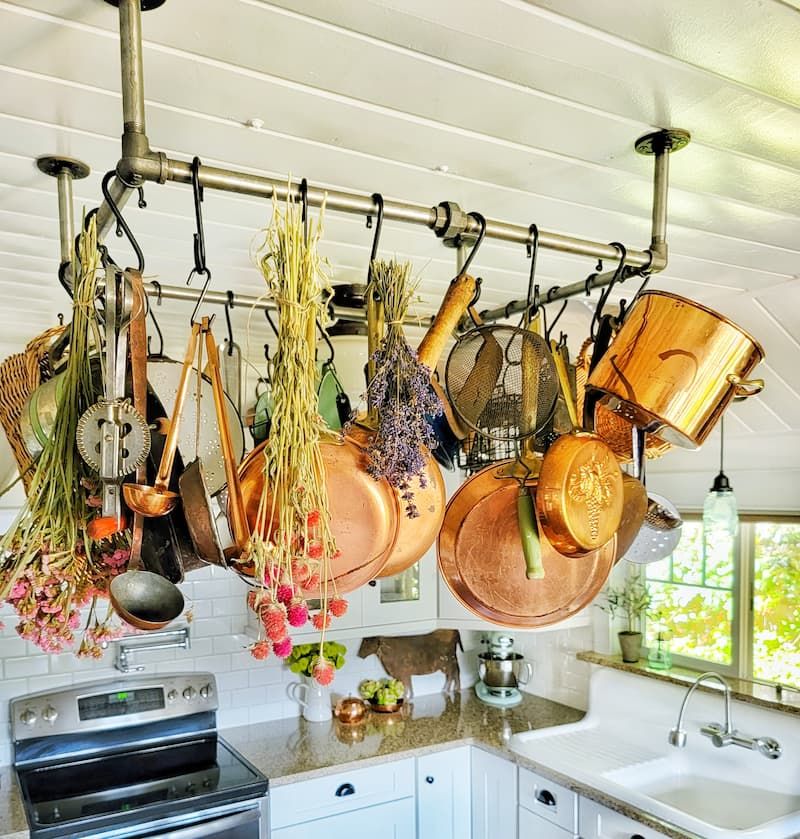
Skip the pristine copper collections that never see a flame. Real cottage kitchens display workhorses – patinaed copper pans with tin linings worn from years of scrambling eggs and reducing sauces.
Mount a simple iron pot rack over your stove or sink. Let copper develop its natural verdigris spots and rosy oxidation. The warm glow catches morning light beautifully, while their accessible placement encourages daily use rather than mere decoration.
8. Layer In Lighting Beyond Overheads
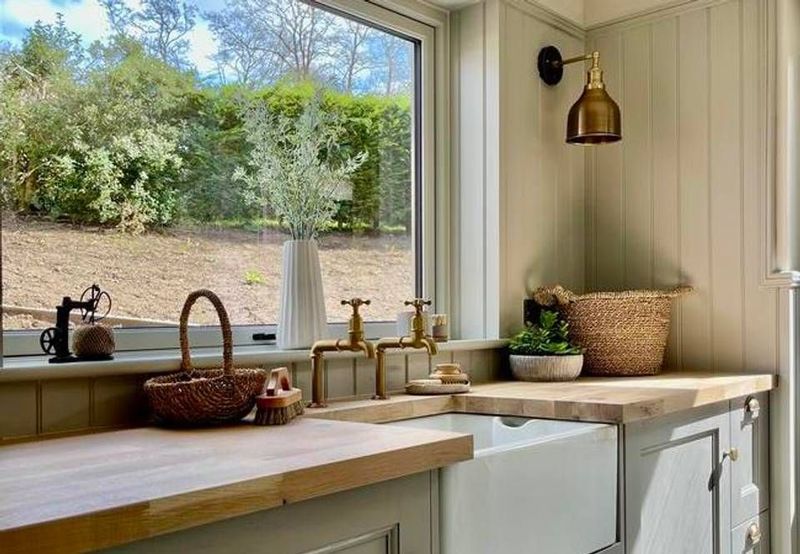
Harsh overhead lighting destroys the gentle ambiance cottage kitchens are known for. Create pools of warm illumination with task lamps on counters and small table lamps tucked into corners.
Look for ceramic bases in crackle glazes or repurposed objects like old coffee grinders or milk cans converted to lamps. Add wall sconces with articulating arms near work areas. The layered light creates the soft glow that makes everyone linger at the table long after meals end.
9. Incorporate A Vintage Rug Instead Of A Runner
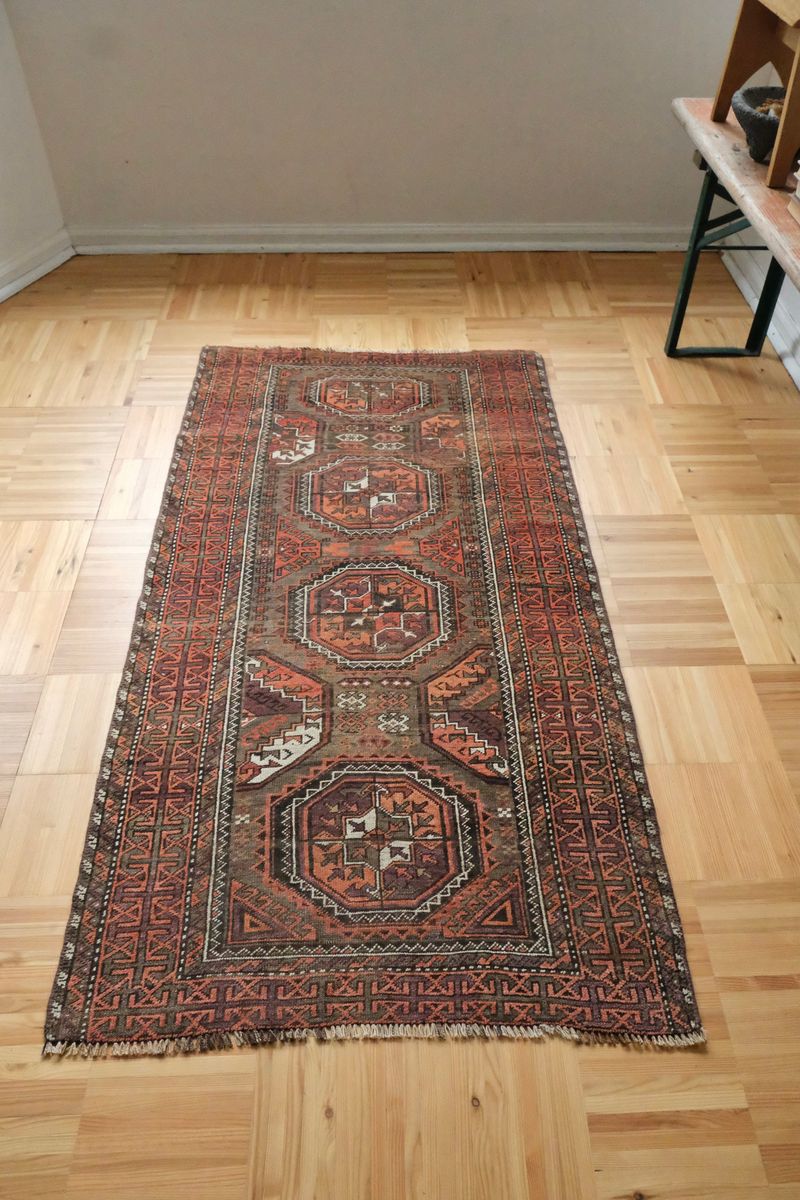
Ditch the washable kitchen runners that scream “practical but boring.” Hunt for faded Oriental carpets or kilim rugs with decades of gentle wear. Their muted colors hide spills while bringing warmth to tile or wood floors.
Unlike pristine new textiles, these rugs improve with coffee drips and flour dustings – becoming part of your kitchen’s evolving story.
10. Display Collections That Work For Their Keep
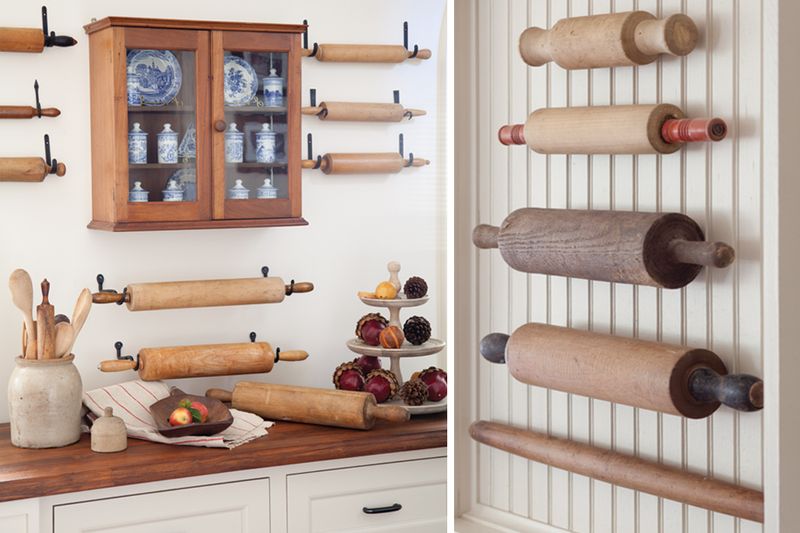
Cottage kitchens celebrate useful collections rather than purely decorative ones. Wooden rolling pins in graduated sizes hang from simple hooks. Vintage bread boards lean against backsplashes, ready for cheese platters or morning toast.
Gather ironstone pitchers to hold wooden spoons and utensils. Stack cake stands of varying heights for serving or displaying fruit. When collections earn their space through regular use, they bring both beauty and function – the hallmark of authentic cottage style.
11. Install Beadboard For Instant Age
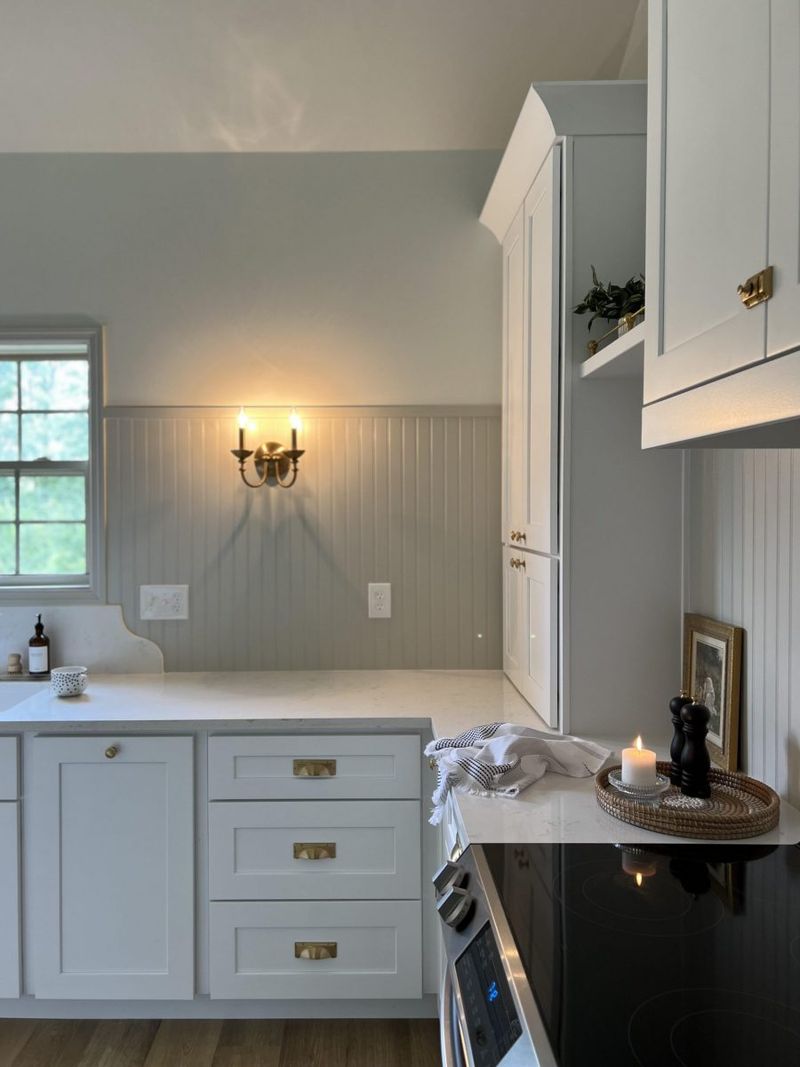
Nothing says “cottage” quite like beadboard paneling with its rhythmic vertical grooves. Apply it as backsplashes, cabinet faces, or halfway up walls as wainscoting. The texture immediately adds architectural interest to plain rooms.
Paint it in soft whites or creams that will eventually chip and wear at corners. For extra authenticity, look for salvaged beadboard from old homes, complete with nail holes and weathering. Modern vinyl versions might be easier to install, but lack the subtle imperfections that give true character.
12. Create A Window Herb Garden
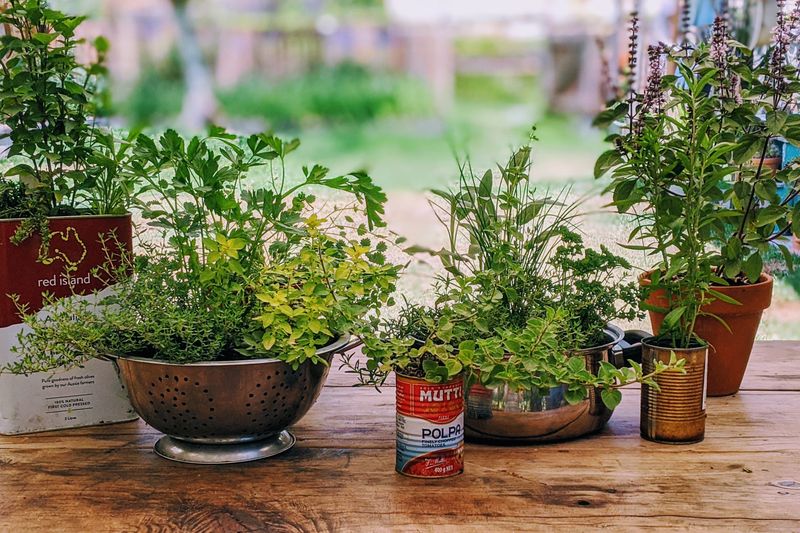
Cottage kitchens blur the line between indoor and outdoor living. Cluster terracotta pots of rosemary, thyme, and basil on windowsills where they’ll thrive in sunlight while flavoring your cooking.
Mismatched containers work perfectly – try enamelware cups with chips, mason jars, or even repurposed tin cans with handwritten labels. The greenery softens hard kitchen surfaces while providing fresh snippings for morning eggs or evening pasta. Plus, their gentle fragrance welcomes you each time you enter.
13. Hang Simple Cafe Curtains

Floor-length drapes feel formal and collect kitchen grease. True cottage windows wear breezy cafe curtains that cover just the lower half of windows, providing privacy while welcoming in abundant natural light.
Choose humble fabrics like ticking stripes, small florals, or tea-stained linen. Thread them on simple tension rods or, better yet, actual branches stripped of bark. The gentle movement of these unassuming textiles in the breeze adds life to your kitchen without blocking the connection to outdoors.
14. Incorporate A Farmhouse Table For Gathering

The heart of cottage kitchens isn’t the island – it’s the well-loved table where family gathers. Look for solid wood farmhouse tables with turned legs and planked tops bearing evidence of homework sessions and holiday feasts past.
Surround it with mismatched chairs unified by similar heights or a fresh coat of milk paint. Position it where morning light will pool across its surface. Unlike precious dining furniture, these tables welcome hot pots without trivets and encourage elbows during animated conversations.
15. Swap Out Standard Faucets For Aged Brass
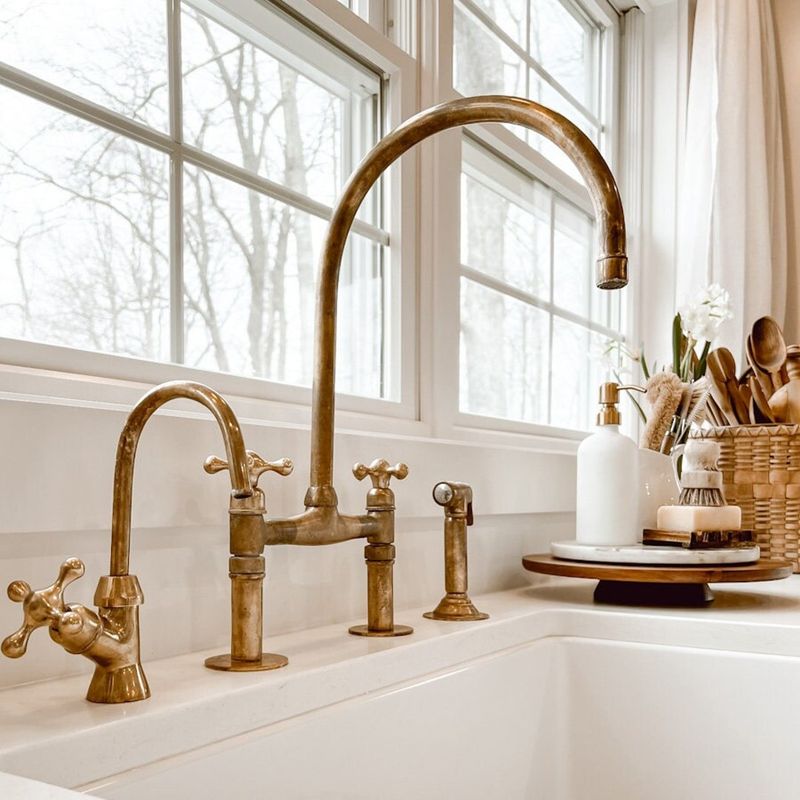
Builder-grade chrome faucets feel sterile and forgettable. Replace yours with unlacquered brass fixtures that develop a living patina with every touch and water droplet. Bridge-style faucets with separate hot and cold handles offer authentic cottage appeal.
Even in a rental, this single swap transforms your sink area into a focal point. The warm metallic tones complement wooden counters and vintage elements throughout your kitchen.
16. Hang Practical Textiles As Decor
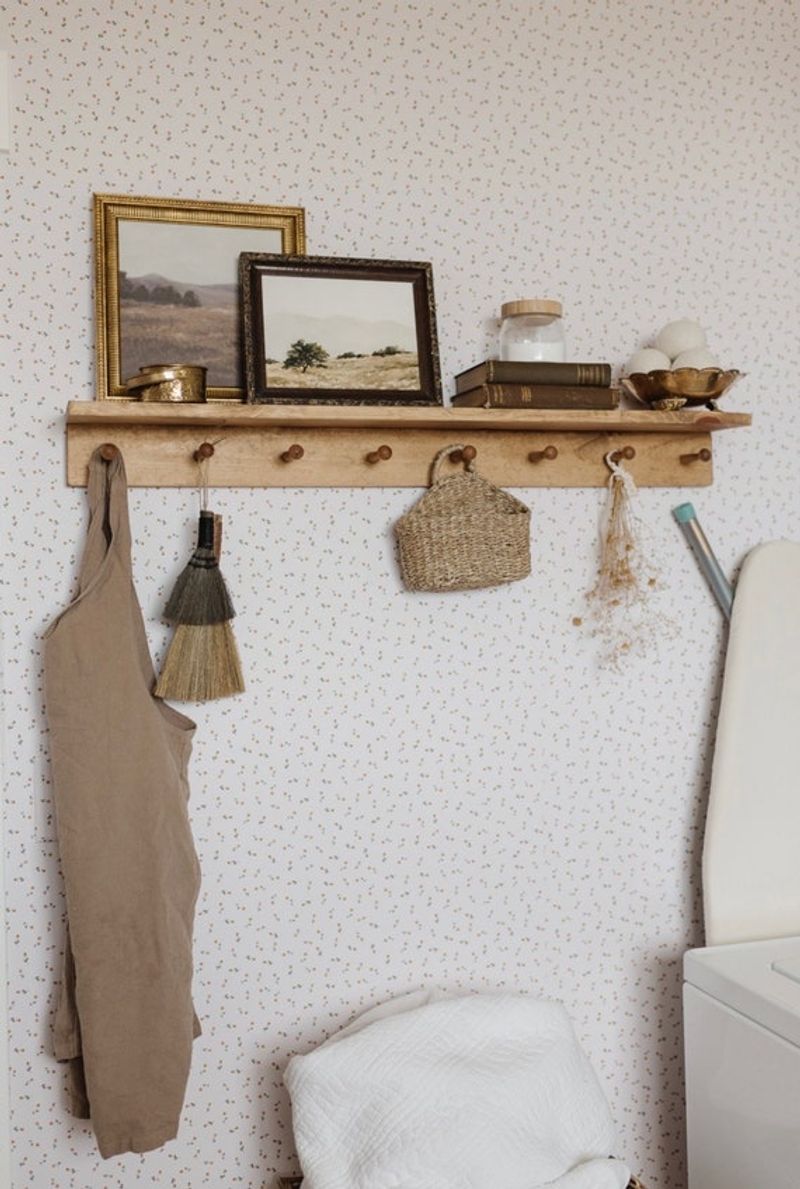
Cottage kitchens display linens meant for daily use, not just decoration. Install simple wooden pegs or a vintage drying rack to showcase hand-embroidered dish towels, sturdy aprons with faded prints, or linen bread bags.
The textiles should rotate regularly between wall and hand – used for wrapping warm loaves or drying just-washed plates. Their slightly rumpled, freshly-laundered appearance brings softness to utilitarian spaces. Bonus points for textiles bearing mending marks or monograms from previous generations.
17. Ditch Upper Cabinets For Plate Racks
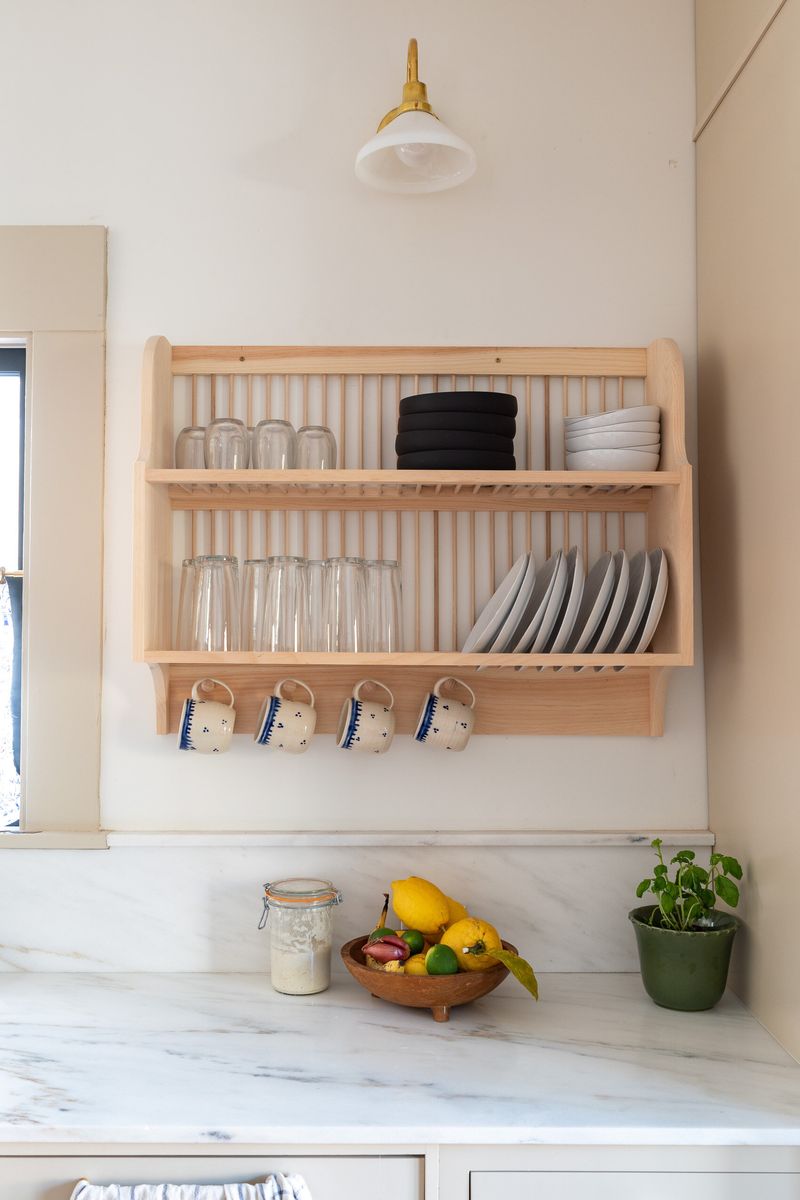
Upper cabinets with solid doors create visual heaviness. Replace some (or all) with open plate racks where everyday dishes stand vertically, ready for grabbing. Water droplets occasionally left behind create no issues – they simply dry in the open air.
The vertical storage maximizes space while creating a display that changes naturally with meals and seasons. Your grandmother would approve of this perfect blend of practicality and unpretentious display.
18. Add Wood Paneling For Warmth
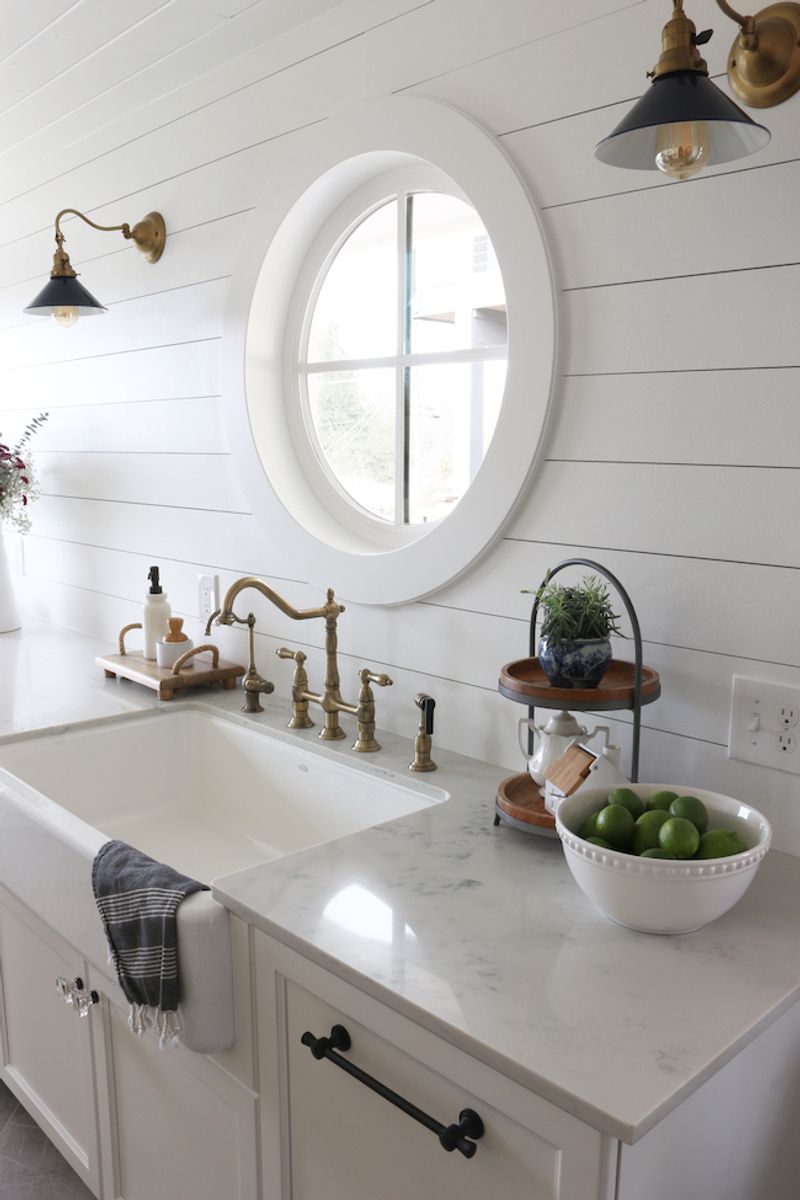
Flat drywall feels sterile and unfinished in cottage spaces. Consider adding horizontal shiplap, vertical board-and-batten, or even reclaimed barn wood to walls. The natural texture immediately warms the room and provides subtle architectural detail.
Paint it in soft, chalky finishes or leave sections in natural wood tones. Unlike trendy temporary paneling, aim for authentic materials installed with proper reveals between boards. The shadow lines create depth that changes throughout the day as sunlight moves across your kitchen.

